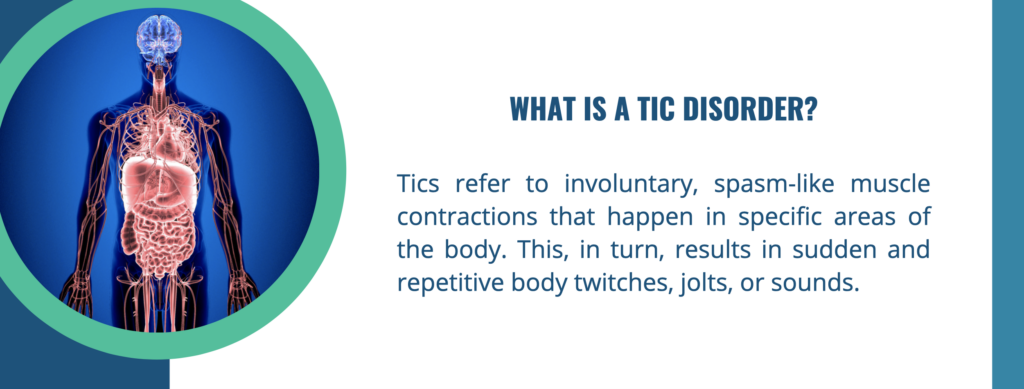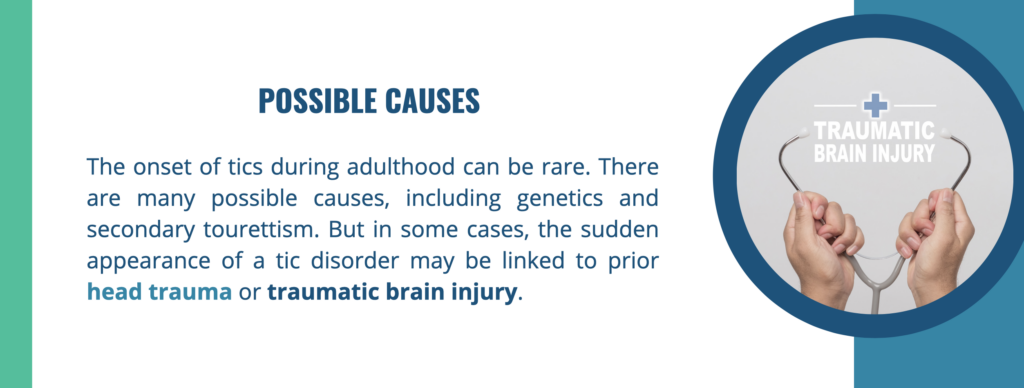Head trauma can cause several different symptoms一from vomiting and persistent headaches to loss of consciousness or seizures. It can also cause various types of post-traumatic movement disorders that are usually harmless but can still bring psychological and emotional distress to the patient—one such example of a movement disorder after head trauma is tics.
Read on below for an in-depth discussion on tic disorder and how inpatient brain injury rehabilitation can help treat this condition.
Tics refer to involuntary, spasm-like muscle contractions that happen in specific areas of the body. This, in turn, results in sudden and repetitive body twitches, jolts, or sounds.
Normally, a tic disorder is not a cause for concern since they’re fairly common in children five years of age. In fact, studies suggest that 10% of children develop transient tics during their early school years. Fortunately, such conditions improve and resolve themselves naturally over time.
The onset of tics during adulthood can be rare. There are many possible causes, including genetics and secondary tourettism. But in some cases, the sudden appearance of a tic disorder may be linked to prior head trauma or traumatic brain injury.

Tics following a head injury are known to occur in some patients suffering from moderate to severe TBI. According to studies, about 13% to 66% of patients with severe traumatic brain injury developed some kind of movement disorder, including tics.
As of now, science has yet to discover the exact cause of a tic disorder. However, research indicates that multiple factors may influence the onset of tics after head trauma. This includes the following:
After a head or brain injury, patients may experience tics days or weeks after the incident. However, there are reported cases wherein tics develop only after a year post-TBI.
Tics start as a strong and unpleasant urge to carry out a specific movement or vocal tic. This sensation builds up in the body and may only be relieved once you do the tic. Some people may suppress this urge, but doing so can cause significant stress and tension.
There are many types of tic disorders which may be classified based on their symptoms and the kind of movement they present. For example, a tic may either be:
Tic disorders may also be classified depending on the symptoms the patient exhibits. This includes the following:
Motor tics refer to uncontrolled movements involving one or more muscle groups, specifically in the eyes, mouth, face, neck, and shoulders. They can either be simple (fleeting and meaningless gestures) or complex (patterned movements). Some of the most common symptoms of this condition are:
Tic disorders that develop after a head injury usually affect the head and facial muscles first. Over time, it may also affect other muscle groups in the body.
Vocal or phonic tics are unintentional and often meaningless sounds or phrases uttered by someone with a tic disorder. Typically, it only involves simple sounds made from the nose and mouth, such as grunting, sniffing, snorting, throat clearing, and barking. However, this is not always the case.
Patients with complex vocal tics may actually utter specific words, phrases, and sentences. They are usually spoken in a louder tone and often happen at the beginning or during a conversation. Some examples include:
Although harmless, vocal tic disorders usually cause psychological and emotional stress to the patient due to the stigma associated with them.
Tourette’s syndrome is a more severe variant of a tic disorder that involves both motor and vocal tics. This condition is usually inherited genetically, but research suggests that head trauma may increase one’s risk of developing Tourette's syndrome.

Tics due to TBI may not be life-threatening, but they can cause severe emotional trauma, social problems, and even mental health problems. It can also disrupt everyday activities and may cause harm to the patient or another person. Doctors usually treat tic disorder using different approaches, such as:
Habit reversal therapy (HRT) refers to a therapeutic technique used to treat unwanted behaviors, habits, and tics. Doctors and physical therapists usually use this therapy as the first line of defense against tic disorders. HRT is comprised of four stages:
HRT and other cognitive behavioral therapy can also help a patient recover from their head injury or traumatic brain injury.
ERP refers to a behavioral therapy that exposes the patient to thoughts and situations that usually trigger their tic disorder while in a safe environment. Through the guidance of an expert therapist, you will confront your triggers and do your best to avoid your compulsive tics and behaviors.
ERP exercises allow patients to get used to their triggers or the unpleasant sensations that come before a tic behavior. As a result, they’ll be able to tolerate these urges and work their way through them without doing the tic.
Doctors can also prescribe some medications combined with ERP or HRT therapy. According to studies, some examples of drugs that can help manage tic disorders include antipsychotics (haloperidol), SSRIs, tricyclics, dopamine blocking agents, and alpha 2 agonists.

Tics may be harmless, but they should not be a normal part of your life. If you or a loved one experienced a brain injury and suffers from a tic disorder, then our expert specialists at NeuLife can definitely help.
NeuLife Rehabilitation is one of Florida's leading providers of quality rehabilitative services. We use a patient-centered approach to meet the current abilities, medical needs, and goals of each of our patients. Some of the programs and services we offer include:
And more!
Each of our programs is designed to treat your symptoms, help you recover from your injuries, and aid you in transitioning seamlessly into the community.
If you think you or someone you know can benefit from our services, don’t hesitate to call us at 800-626-3876. We are more than happy to answer your questions and concerns. You can also schedule a tour.
The material contained on this site is for informational purposes only and DOES NOT CONSTITUTE THE PROVIDING OF MEDICAL ADVICE, and is not intended to be a substitute for independent professional medical judgment, advice, diagnosis, or treatment. Always seek the advice of your physician or other qualified healthcare providers with any questions or concerns you may have regarding your health.

We know that choosing the next step in your recovery from a catastrophic illness or injury is complex. Together, we can help you take the next step.
Contact us with any questions today.